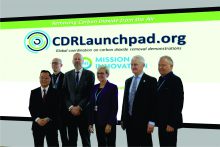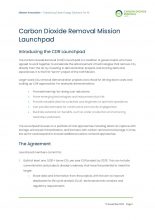NEWS AND UPDATES
- [February 13, 2024] The CDR Missions is pleased to announce it will launch a global monitoring, reporting, and verification (MRV) student prize competition in spring 2024. More details on how to apply coming soon. Other governments, companies, researchers, and organizations are encouraged to get involved by contacting the Mission.
- [January 30, 2024] The CDR Mission launched the Direct Air Capture (DAC) workstream, one of the CDR Mission’s three priority technological approaches to CDR. Canada and the United States are co-leading this workstream, supported by the Kingdom of Saudi Arabia, the United Kingdom, Norway, Australia, and Japan. During the kick-off meeting, members identified priorities to advance global DAC RD&D in collaboration.
- [December 4, 2023] At a join CEM CCUS – Mission Innovation CDR event, the role and status of carbon dioxide removals was discussed, with speakers ranging from technology providers, industry, government, academia, and removal certification organizations. Recording here. The COP Presidency also hosted a roundtable dialogue on the Carbon Management Challenge (CMC), a joint effort and call to action by countries worldwide to accelerate the deployment of carbon capture, removal, use, and storage technologies.
- [December 3, 2023] As part of COP28, the Carbon Dioxide Removal Mission has today launched the 2023-2026 Work Plan for the Enhanced Mineralization Technical Track. This international effort, led by Australia and the Kingdom of Saudi Arabia, sets out the next steps for the global community to unlock the potential of enhanced mineralisation to play a central role in reaching national- and global net zero goals.
- [November 1, 2023] Learn how you can collaborate with the CDR Mission to help us achieve our goals by reading the Mission’s Stakeholder Engagement Plan here. You can contact us to discuss partnership opportunities at: juho.k.lipponen@outlook.com
- October 30, 2023] The CDR Mission’s BiCRS technical track invites you to attend the “Presentation of international BiCRS projects: Potentials, diversity, and gaps for common goals” on November 2nd, 2023. Find the full program here, and additional information from the Global Zero Emission Research Center here.
- [June 1, 2023] Australia and the Kingdom of Saudi Arabia launched the Enhanced Mineralization workstream of the CDR Mission, hosting a workshop to facilitate knowledge exchange between participating countries and to develop the work plan needed to unlock it’s local and global CDR potential.
- [May 5, 2023] The CDR Mission has launched the Action Plan for the Life Cycle Analysis (LCA) and Techno-economic Assessment (TEA) Technical Track, co-led by Canada and Japan. Read the Action Plan here.
- [December 22, 2022] The CDR Mission has released a Scope of Work for the Biomass Carbon Removal and Storage (BiCRS) technical track. Check it out here!
- [November 17, 2022] The CDR Mission announced the Launchpad sprint project at COP27. Watch the recorded event here!
- [September 23, 2022] The CDR Mission released its Innovation Roadmap and Action Plan at the Global Clean Energy Action Forum (GCEAF).
- [September 23, 2022] At the GCEAF, the CDR Mission launched the Carbon Dioxide Removal Launchpad, a global push for CDR pilot-scale tests and demonstrations projects.
- [November 5 , 2021] The Carbon Dioxide Removal Mission was announced at COP26. Read our joint mission statement for more information.
Follow us on LinkedIn
The Co-leads: United States Saudi Arabia Canada
- United States of America, Department of Energy
- Kingdom of Saudi Arabia, Ministry of Energy
- Canada, Natural Resources Canada
Core Mission Members:
- Norway, Gassnova
- Japan, Ministry of Economy, Trade and Industry
- Australia, Commonwealth Scientific and Industrial Research Organization (CSIRO)
Mission Support Group:
- European Commission, Directorate-General for Research & Innovation
- India, Ministry of Science and Technology (DBT and DST)
- United Kingdom, Department for Business, Energy, and Industrial Strategy
Find out more about the Carbon Dioxide Removal Mission.
CDR Demonstration and Deployment Map
The Global Carbon Dioxide Removal (CDR) Demonstration and Deployment Map is an interactive tool to enhance awareness of the global landscape of CDR projects across the Mission’s three technological focus areas: Direct Air Capture (DAC), Biomass with Carbon Removal and Storage (BiCRS), and Enhanced Mineralization (EM). The current beta version—launched during the MI-8 Ministerial in Goa, India—includes known pilots, demonstrations and deployments at varying stages of development, using best available data. As projects are at different levels of technological readiness, and may have significantly different carbon removal capacities, projects across or within technological approaches should not be considered commensurate.
Project inclusion on the map does not signal net-negative operations in the present but represents technologies enabling the path to net-negativity and scale-up of the global carbon dioxide removal industry. As such, the scope of technologies included in the map is broader than the focus of the CDR Mission itself.
The map represents the most up-to-date information available to us at the time of publishing, and will be updated on a quarterly basis to reflect the rapid pace at which the industry is evolving.
Information in this tool is presented for informational purposes only. MI does not endorse any companies or related products.
For information about the MI-identified CDR projects around the world, check out our interactive map below.
CDR LAUNCHPAD

The Carbon Dioxide Removal (CDR) Launchpad is a coalition of governments who have agreed to work together to accelerate the pace of CDR advancements through large demonstration projects and share data and experiences. It is the first “sprint” project of the CDR Mission.
Demonstration projects of 1,000 tonnes or more per year of CO2 removal are critical for driving down costs and scaling up CDR approaches. The Launchpad focuses on a portfolio of CDR approaches including direct air capture with storage, enhanced mineralization, and biomass with carbon removal and storage. In time, this sprint could expand to include additional carbon removal approaches.
Members who have joined the Launchpad include Canada, the European Commission, Iceland, Japan, Norway, the United Kingdom, and the United States. The Launchpad is a call to action and both Mission Innovation members and non-MI members are encouraged to join.
The Mission’s CDR Launchpad is an important step towards rapidly and responsibly bringing the carbon dioxide removal industry to giga-tonne scale, which the IPCC indicates is needed alongside deep decarbonization to achieve the Paris Agreement goals.. The efforts made by this coalition will help increase the number of pilot-scale tests and demonstrations of CDR technologies by ten times from 2022 levels within three years, and grow the number of full-scale commercial CDR demonstrations to more than a dozen within six years.
Read information about Launchpad member projects here.
Read more about the CDR Mission Launchpad here.
